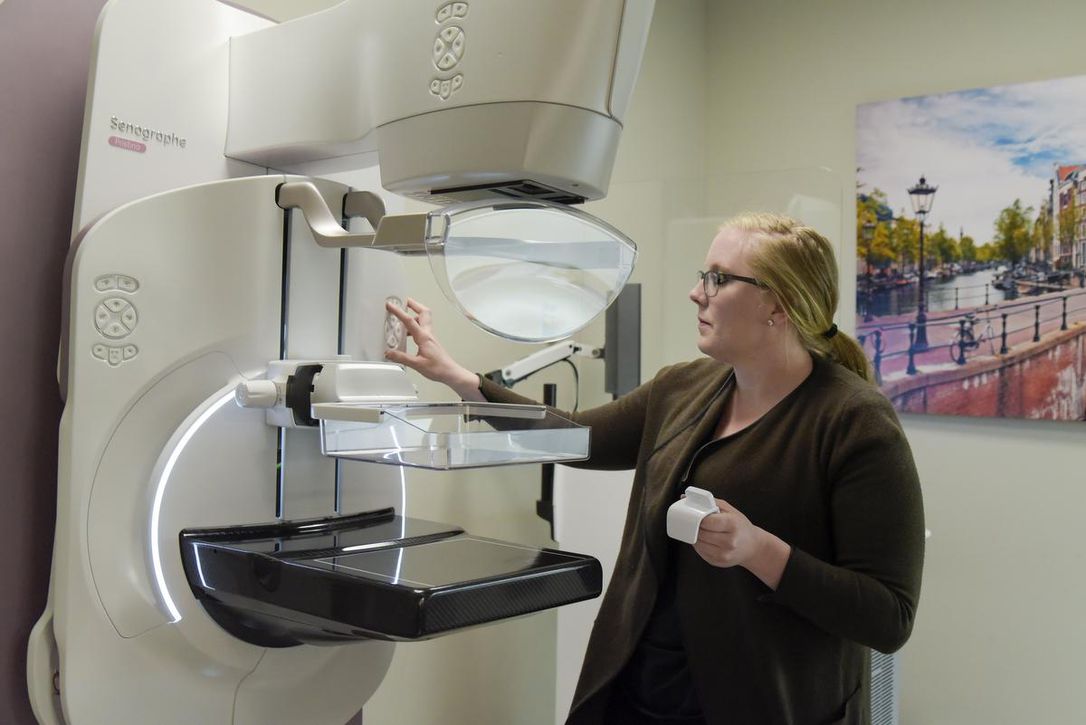 It’s not something you’ll necessarily look forward to, but a new innovation in mammography technology is giving Canadian women one less reason to avoid an exam.
It’s not something you’ll necessarily look forward to, but a new innovation in mammography technology is giving Canadian women one less reason to avoid an exam.
Breast cancer affects one in eight women in Canada, and one in 32 will die from it, according to the Canadian Cancer Society. It can also affect men.
Women in Alberta aged 50 to 74 can book a mammogram without a referral, but data from Alberta Health Services (AHS) cancer screening programs shows just 63 per cent of women in that age group actually went for an exam during 2015 and 2016.
The Senographe Pristina, designed by GE Healthcare Canada, hopes to change that by giving patients the power to adjust the level of breast compression during a mammogram.
After a technologist positions their breast on the machine’s imaging detector, a patient uses a wireless remote control to adjust the amount of pressure to a level they’re comfortable with — with the guidance of the technician, of course.
Heather Chalmers, president of GE Healthcare Canada, said they wanted to encourage more women to get screened for breast cancer by taking some of the fear out of the mammogram.
“The hope is more patients come for their prescribed mammograms,” Chalmers said, adding more than 1,200 women technologists, radiologists and patients were part of the design process.
“Right now, 25 to 46 per cent of women never come back for a subsequent mammo because of the poor experience they had. And then, ultimately, they run the risk of not getting early diagnosis and that can impact mortality rates due to breast cancer.”
Two Mayfair Diagnostics clinics in Calgary have been using the Pristina system for a little more than a month.
It’s the first time the technology has been used in a clinical setting, and it’s been received so well that Mayfair plans to acquire machines for its other locations.
Out of more than 400 patients who have been surveyed by Mayfair about their experience, 75 per cent said it was more comfortable than previous mammograms, and 90 per cent said they would be “extremely likely” to come back for their regular screening — which ideally should happen at least every two years for women 50 and older, according to AHS.
One of those women, Donna Grandan, said she was anticipating the pain she’s felt at previous exams — but it never came.
“I said, ‘I’m ready’ and they said it was done already,” Grandan said, laughing.
“It was painless and quick. I was amazed at how it all happened.”
Katie Kaminski, Mayfair’s mammography co-ordinator in Calgary, said they’ve noticed patients will apply more pressure than they would tolerate if a technician was in control.
“They’re more willing to apply the compression knowing they’re in complete control,” Kaminski said.
The biggest difference the machine makes for technicians is patients are more relaxed, she said, and a relaxed patient means capturing a better image.
“If you’re tense, and we’re complying compression, it’s going to hurt more. So, if the patient is relaxed when they apply the compression, it’s not as painful — and they can apply more,” Kaminski said.
“We try our hardest — you know, we make conversation, we try to make them relaxed — but having a machine that’s more comfortable for them really helps.”
Grandan said she hopes by sharing her experience, more women will get screened.
“It’s a really good thing for women who are fearful of the pain,” she said.
“This machine could save your life and certainly lengthen your life in helping you catch (cancer) early.”
This article was originally published on May 10, 2018 by Elizabeth Cameron, StarMetro Calgary.
